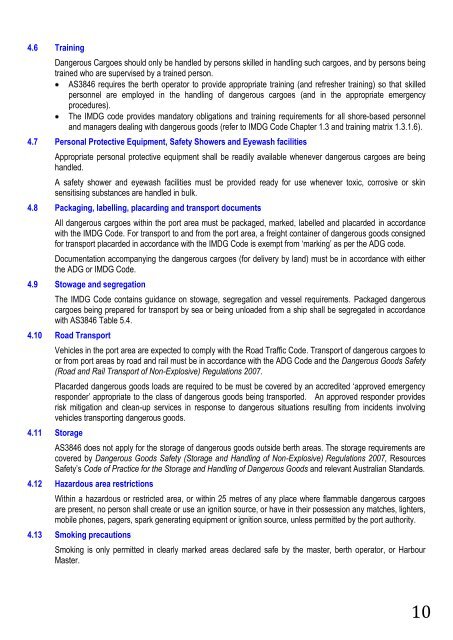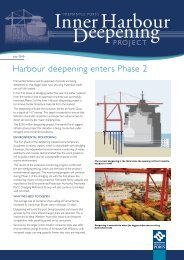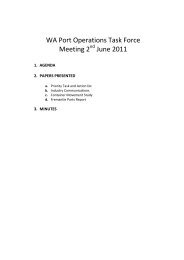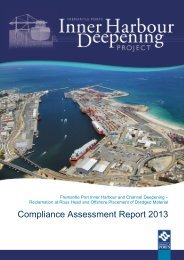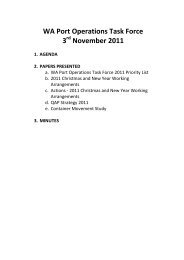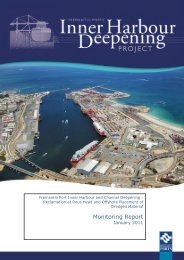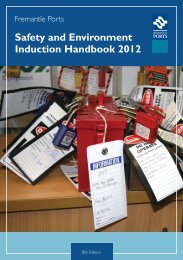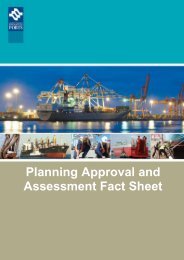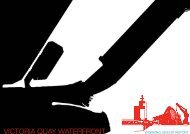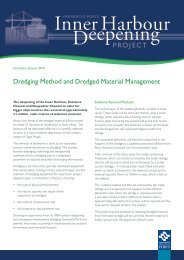Dangerous Cargoes Standard - Fremantle Ports
Dangerous Cargoes Standard - Fremantle Ports
Dangerous Cargoes Standard - Fremantle Ports
- No tags were found...
You also want an ePaper? Increase the reach of your titles
YUMPU automatically turns print PDFs into web optimized ePapers that Google loves.
4.6 Training<strong>Dangerous</strong> <strong>Cargoes</strong> should only be handled by persons skilled in handling such cargoes, and by persons beingtrained who are supervised by a trained person.AS3846 requires the berth operator to provide appropriate training (and refresher training) so that skilledpersonnel are employed in the handling of dangerous cargoes (and in the appropriate emergencyprocedures).The IMDG code provides mandatory obligations and training requirements for all shore-based personneland managers dealing with dangerous goods (refer to IMDG Code Chapter 1.3 and training matrix 1.3.1.6).4.7 Personal Protective Equipment, Safety Showers and Eyewash facilitiesAppropriate personal protective equipment shall be readily available whenever dangerous cargoes are beinghandled.A safety shower and eyewash facilities must be provided ready for use whenever toxic, corrosive or skinsensitising substances are handled in bulk.4.8 Packaging, labelling, placarding and transport documentsAll dangerous cargoes within the port area must be packaged, marked, labelled and placarded in accordancewith the IMDG Code. For transport to and from the port area, a freight container of dangerous goods consignedfor transport placarded in accordance with the IMDG Code is exempt from „marking‟ as per the ADG code.Documentation accompanying the dangerous cargoes (for delivery by land) must be in accordance with eitherthe ADG or IMDG Code.4.9 Stowage and segregationThe IMDG Code contains guidance on stowage, segregation and vessel requirements. Packaged dangerouscargoes being prepared for transport by sea or being unloaded from a ship shall be segregated in accordancewith AS3846 Table 5.4.4.10 Road TransportVehicles in the port area are expected to comply with the Road Traffic Code. Transport of dangerous cargoes toor from port areas by road and rail must be in accordance with the ADG Code and the <strong>Dangerous</strong> Goods Safety(Road and Rail Transport of Non-Explosive) Regulations 2007.Placarded dangerous goods loads are required to be must be covered by an accredited „approved emergencyresponder‟ appropriate to the class of dangerous goods being transported. An approved responder providesrisk mitigation and clean-up services in response to dangerous situations resulting from incidents involvingvehicles transporting dangerous goods.4.11 StorageAS3846 does not apply for the storage of dangerous goods outside berth areas. The storage requirements arecovered by <strong>Dangerous</strong> Goods Safety (Storage and Handling of Non-Explosive) Regulations 2007, ResourcesSafety‟s Code of Practice for the Storage and Handling of <strong>Dangerous</strong> Goods and relevant Australian <strong>Standard</strong>s.4.12 Hazardous area restrictionsWithin a hazardous or restricted area, or within 25 metres of any place where flammable dangerous cargoesare present, no person shall create or use an ignition source, or have in their possession any matches, lighters,mobile phones, pagers, spark generating equipment or ignition source, unless permitted by the port authority.4.13 Smoking precautionsSmoking is only permitted in clearly marked areas declared safe by the master, berth operator, or HarbourMaster.10


